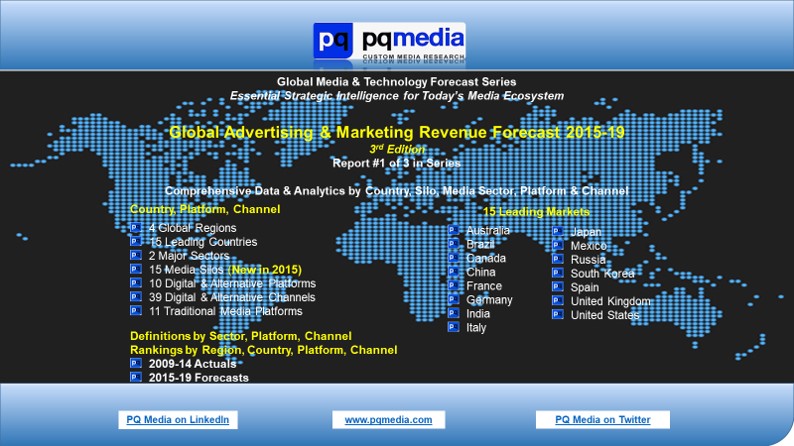Your cart is currently empty!
Research Reports
Global Advertising & Marketing Forecast 2015-19
Description
“Fueled by a global transformation that has pushed the media ecosystem past the digital tipping point, the fragmentation of the advertising and marketing economy has accelerated as advertisers, agencies, content producers and media investors scramble to redevelop strategic growth plans. The key to your success will be your ability to make smarter, faster business decisions in this era of frenetic changes spanning media, entertainment and technology.
It is with this rapidly shifting landscape in mind that PQ Media launched the Global Media & Technology Forecast Series in 2013. This groundbreaking, three-report series is the first and only market research service to track, analyze and forecast the trajectory and velocity of the evolving global media ecosystem by region, country, sector, channel, technology and generation. Each of the three installments in the Series delivers exclusive data and comparisons of digital and traditional media, while focusing on one of three key performance indicators (KPI’s): media operator revenues; consumer media usage & exposure; and consumer spending on media content, access and technology.
This first report in the 2015 Series – the Global Advertising & Marketing Revenue Forecast 2015-19 – delivers exclusive data and analytics covering media operator revenues and growth, key market drivers and challenges, and US and global rankings, among other actionable intelligence that will better equip you to:
- Benchmark KPI’s in the 4 major regions worldwide; the 15 largest global markets; 2 key revenue sectors; 15 media silos (NEW); 10 digital & alternative media platforms; 11 traditional media platforms (NEW); and 39 digital & alternative media channels;
- Drill down into the Top 15 Global Markets with the exclusive value-add Excel Databook, which provides hundreds of datasets, market-specific insights and 5-year projections in a rich 444-slide PowerPoint deck featuring nearly 90,000 data points;
- Compare and contrast the advertising and marketing sectors, digital and traditional media platforms, and GDP growth in each vital market, global region, and worldwide;
- Analyze the 2009-19 period, including 2014 actuals, 2015 pacing and 2015-19 forecasts, with more than 850 datagraphs, and identify countries with the greatest investment opportunity based on exclusive growth projections;
- NEW in this edition are expanded coverage of traditional media with in-depth datagraphs and analysis of the overall advertising and marketing industry, such as new segmentation and data by combined digital & traditional media silos (ex., total direct marketing and overall broadcast TV advertising, combining traditional and digital platforms and/or channel revenues, like terrestrial TV + online TV + mobile TV advertising).
In designing the only comprehensive, consistent and actionable source of strategic media intelligence, PQ Media’s core objective was to help you navigate the strong cross-currents reshaping the global media ecosystem. As such, PQ analysts researched and developed the Global Media Intellicast Series with the support of our time-tested PQ Medianomics™ methodology, a proprietary econometric research system that has set the standard for mapping the worldwide consumer-facing media economy.
Along with decades of proprietary research and thorough PEST examination, PQ analysts have drilled deep into key markets worldwide to uncover several important trends that emerged in the 2009-14 period, including:
- Surging demand from post-Baby Boomer generations for wireless devices, broadband access and digital content is hastening the shift of advertising and marketing dollars to digital media;
- Multitasking with various media and technologies has become the norm in developed countries like the US, the UK and Australia;
- Emerging middle class in developing nations, such as Brazil, India and China, are demanding faster access to richer content, leading to upgraded broadband and wireless systems, which has fueled the growth of time and money spent on mobile data plans, internet access and over-the-top video.
Driven by these key trends, the new Global Advertising & Marketing Revenue Forecast 2015-19 found that:
- Global advertising and marketing revenues exceeded $1 trillion for the first time in 2014, with combined digital and traditional media growing 4.5% over 2013;
- Digital & alternative media expanded 12.8% in 2014 to $287.2 billion, while traditional advertising & marketing inched up 1.6% to $739.0 billion;
- US remained the world’s largest media market in 2014, generating $358.91 billion, but ranked 6th globally with overall growth of 4.4%;
- Direct marketing (digital & traditional) was the largest of the 15 media silos tracked, with revenues of $217.3 billion worldwide, while mobile search marketing was the fastest growing of the 39 digital & alternative media channels, soaring 77% in 2014.
Nevertheless, the abovementioned global trends were buoyed by cyclical drivers in 2014, such as two mega-sporting events and the influx of federal election dollars, which may have masked a combination of potentially adverse secular developments that emerged in 2015. Among them:
- GDP growth continued to decelerate in once red-hot developing markets, like China, Brazil and Russia, exacerbated by charges of fraud and corruption in some instances and geopolitical tensions in others;
- Rapid decline in oil prices and the value of commodities, as well as limp inflation figures from China began to impact developed economies in Top 15 Global Markets, such as the UK and Canada;
- Mixed corporate earnings and a sharp slowdown in US job growth in 3Q15 suggested that the gradually recovering American economy might be losing momentum in the face of slowing global growth.
As a result of these variables PQ Media recalibrated various media growth rates downward in this year’s edition of the Forecast compared with the 2014 version.
With incremental traditional advertising & marketing spend growth trailing GDP going forward, and digital advertising & marketing growth no longer accelerating, there is intensified competition for budgets and stepped-up market share battles looming.
